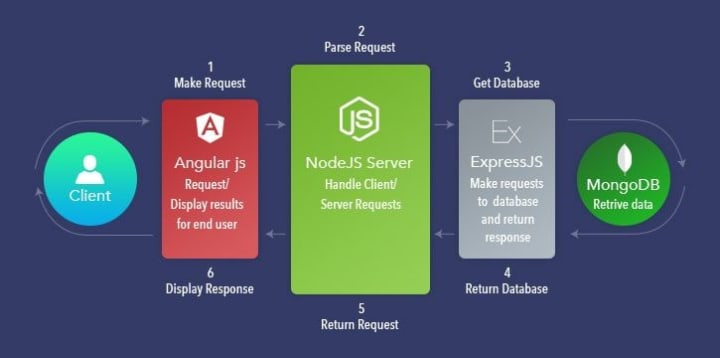How MEAN Stack affects the Global Enterprise Web App Development Space?
The Impact of MEAN Stack on Enterprise Web App Development

Software development could be simple or complex. Yet the success of every software development project, be it a project to build a web app or a mobile app, depends hugely on the technology stack. One may wonder what a technology stack is! Well, it is a pack of technologies that are going to be used to build the front-end and back-end of an app along with the database going to be used. In the web development services domain, MEAN Stack development is quite popular.
Some ten years back, this web technology stack was not even heard by many. Over the years, many web app development companies have been experimenting with vivid combinations of technologies to create a tech stack for achieving the best possible streamlined results for their clients. Today, MEAN Stack for web app development is becoming a top choice, not only among web developers or top MEAN Stack development companies, but also for business owners who are looking to build powerful web applications.
So What is MEAN Stack Anyways?
In simple terms, it is a combo of JavaScript frameworks and a database to create user-friendly, high-performing web applications as per the client’s project and business requirements. The four core technologies resulting the word “MEAN” use JavaScript from top to bottom making it a user-friendly technology stack.
These are MongoDB, Express.js, Angular.js, and Node.js. Let us learn about these four technologies to clear the clouds, shall we?
Database (MongoDB)
MongoDB is a NoSQL database that stores the data structures in binary JSON-esque format. When there is a query from the client-side (front-end), the backend frameworks pass it on to the database. The database gathers all the asked data and returns it to the client. In other words, MongoDB’s role in MEAN Stack is to store the application’s data, process it based on queries, and return it precisely.
MongoDB is well-known for its scalability in both, performance as well as storage and for its proven management capabilities of a larger data set. From a development perspective, it allows Mean Stack developers to add fields to the database table without reloading.
The rival databases of MongoDB are Cassandra, Neo4j, and Couchbase.
Backend Development Frameworks (Express.js & Node.js)
Express.js and Node.js are the next in line. The two work hand-in-hand to build powerful backend applications over the years and are adopted by big brands like LinkedIn, SAP, Microsoft, etc.
Express.js is a flexible and prominent backend web application framework that runs on a Node.js web server. Express.js framework provides a larger set of features and functionalities to build web apps and mobile apps using JavaScript. It is also used to build RESTful APIs using Node.js. Express.js is a lightweight framework that has a user-friendly interface that facilitates communication between the Node.js and MongoDB database.
Node.js is the spine of web applications built using the power of MEAN technologies. As a JavaScript-powered web server that connects with Angular.js (Front-end) and MongoDB for the quickest possible data transmission, in other words, the client-side queries. With an in-built web server, Node.js also makes it possible to deploy your MongoDB database to the cloud. This increases the accessibility of MEAN applications.
The other rival backend frameworks of these are Rails, Django, and Laravel.
Front-end Development Framework (Angular.js)
Angular.js is an open-source client-side JavaScript framework used to build Single Page Web apps like News aggregation web apps, expense tracking apps, and mapping & location apps. Featured with a number of easy-to-use templates to create web pages quickly and efficiently, the MEAN Stack development team can create web apps in a lesser time. It is Angular.js that initiates the data request process upon every request from the users. Angular.js can also work with third-party libraries to create robust web applications with extended functionalities.
As you see, the usage of the same language (JavaScript) to create the front-end and back-end of MEAN Stack applications makes this technology a Go-To option among web developers.
React.js is its fiercest competitor of it along with Ember.js and Backbone.js to build proper web app front-ends.
Anatomy of MEAN Stack Web Applications
The image below shows the MEAN architecture to self-explain what happens when a client (User) makes a request or performs an action.

- As we saw earlier that the front-end is built using the Angular.js framework, and the first process is initiated by Angular.js upon any request from the client.
- Node.js works typically as a runtime JS-based backend server and is connected to Angular.js-powered front-end. It retrieves the information from the front-end and forwards it to the backend framework in the form of Express.js.
- By this time, the request already entered into Express.js is processed. The backend framework (Express.js) creates an inquiry and sends it to the database (MongoDB).
- MongoDB does the rest as it analyzes the inquiry made by Express.js and sends a relevant, precise, and suitable response back to the backend framework (Express.js). This response makes a round trip and goes back to Express.js which in turn, forwards it to Node.js and finally to the front-end (Angular.js).
This whole process is finished in a blink of an eye or a couple of seconds in areas with low internet or connectivity. That’s the beauty of it.
To accelerate your web app development project, you may wish to hire MEAN Stack developers at affordable prices. You can also upgrade or scale up your web development team by opting to hire remote developers.
Nevertheless, in the former case, you must know the basics about one thing explained below.
What Does a MEAN Stack Developer Do?
All the technologies in the MEAN combo are open-source and used to build simple, complex, and dynamic applications. A MEAN developer uses front-end and backend technologies to create a full-fledged web application. That is what a full-stack developer does, right?
The expectations, requirements, and qualifications of a hired MEAN Stack developer are as follows:
- BSc degree in Computer Science or a similar relevant field
- In-depth knowledge of Node.js, Express.js, or Restify
- Experience implementing applications using Angular 1 or React
- Experience creating front-end applications using HTML5, Angular, LESS/SASS
- Hands-on experience with JavaScript Development on both client and server-side
- Experience with modern frameworks and design patterns, minimum one-year experience with MEAN Fullstack paradigm
- Knowledge of the following will be considered as an advantage:
- Consumer Web Development Experience for High-Traffic, Public Facing web applications
- Experience with cloud technologies also a plus
- Creating secure RESTful-based web services in XML and JSON, Javascript, JQuery
- Continuous integration (Jenkins/Hudson) and version control (SVN, Git)
The hired MEAN Stack developer must be able to work at each layer of development. This includes MongoDB, Angular.js, Express.js, and Node.js.
Other responsibilities of MEAN developers in a nutshell:
- Comprehensive web application testing (developed using MEAN Technologies)
- Deployment of web applications
- Creating modules
- Designing databases
- Integration of APIs for extending web application functionalities
Why MEAN Stack is Popular in Enterprise Web App Development Space?
Once upon a time, MEAN Stack was merely a LinkedIn group favorite. And now it is one of the most popular tech stacks used in web application development services globally. What has caused so much stir about MEAN Stack? Let is explore multiple benefits of using MEAN Stack for your next web application development project.
Open-source
Being open-source technologies have multiple benefits. These open-source technologies of MEAN are frequently updated for the betterment of the dev community, which makes them popular among developers.
On the other hand, open-source technologies cost absolutely nothing for MEAN Stack developers to access and use public libraries and repositories if they need to during the web app development process. The developers can also hop on to ongoing discussions, ask queries, and help others to get ideas and solutions to implement them for their ongoing web app development projects.
Vivid Flexibility
One of the resounding advantages is its superior flexibility. This flexibility comes through the MongoDB database and JavaScript programming language.
MongoDB allows the MEAN Stack developers complete flexibility to add extra fields of information to the table in the future without reloading the whole table. This flexibility makes MongoDB well-suited to rapid application development when dealing with fast-changing requirements.
MongoDB also delivers full cluster support along with automatic replication. MongoDB also allows businesses to test their web app on a cloud platform easily with the help of professional QA.
In MEAN web applications, JavaScript is the only coding language used for front-end development and backend development. A universal code created in JavaScript will run on both the client and the server. That offers developers greater flexibility if they decide to change frameworks during development.
MEAN Stack Development is Budget-friendly
In MEAN Stack development to build web apps, business owners will need to hire an extremely lesser number of developers compared to LAMP Stack.
The reason is MEAN Stack only uses JavaScript-based frameworks and tools. This shows that there will rarely be a requirement to hire specific resources apart from JS. Whereas, LAMP Stack development demands that business owners hire proficient developers in multiple technologies like JavaScript, PHP, and MySQL.
Uniform resource requirements in MEAN Stack bring down the hiring cost significantly due to its simplified architecture and versatile coding language.
Faster Development for Early Launch
MEAN Stack development has an upper hand in the enterprise web app development space when it comes to launching web apps within strict deadlines. The MEAN Stack developers can rely on the ready-to-use module libraries of Node.js for the backend. Angular.js also offers templates to be used in the front-end, and Express.js is already versatile to add features easily.
MEAN Stack offers an optimized development environment, as the developers automatically get notified when a feature is broken. It allows you enough time to fix and move on.
MEAN uses JSON to store structured data in binary leveraging the MongoDB database. All four technologies use JSON and hence it eliminates the need to restructure the format every time a request is made from the client. MEAN Stack helps to make changes in real-time as it uses SPAs. This eliminates the need to refresh the whole page every time a server request is generated.
Ideal for Enterprise Applications Development
MEAN Stack developers can easily build and implement new modules, features, and functionalities using third-party APIs during and even after the web app is developed. The MEAN development team will find it easy to create custom prototypes and scalable enterprise web applications as per the bespoke project needs.
The benefits associated with the scalability and flexibility of MongoDB allow the MEAN Stack developers to add an unlimited number of nested fields of new structured binary JSON data. This makes MEAN Stack well-suited to rapid enterprise app development as they have to frequently deal with fast-changing and evolving market requirements.
How much Would it Cost to Hire MEAN Stack Developers?
As of December 2019, Talent.com says the median salary by hiring MEAN stack developers can expect is around $125,000/year per resource. Indeed.com reports MEAN stack developers in with full-stack developers more generally and pegs the typical annual salary at around $112,000.
To be honest, the cost of hiring a MEAN Stack expert depends on the project experience (in years), unique requirements, scope, and nature of every business requirement, and complexity to create custom modules. The reason is that every software development project demands something unique and which is why it is hard to say what would be the cost.
Looking to Hire Top MEAN Stack Experts?
However, the aforementioned costs are given for an annual dedicated engagement on a full-time basis. If you are an enterprise and want to opt for a fixed cost model, find the right MEAN Stack development company that can guide you through what exactly your enterprise needs instead of just jumping on with the project.
As they say, don’t look for faster responses, instead, look for recommendations they give!
About the Creator
Mitul Patel
Mitul Patel Founder & CEO at Bytes Technolab Inc. with a demonstrated history of scaling up the company in the ever-competitive Software Industry. An elite mentor & problem-solver to a dev team of 120+ software experts.
Enjoyed the story? Support the Creator.
Subscribe for free to receive all their stories in your feed. You could also pledge your support or give them a one-off tip, letting them know you appreciate their work.






Comments
Mitul Patel is not accepting comments at the moment
Want to show your support? Send them a one-off tip.